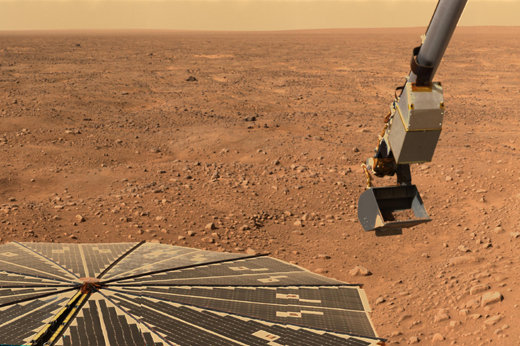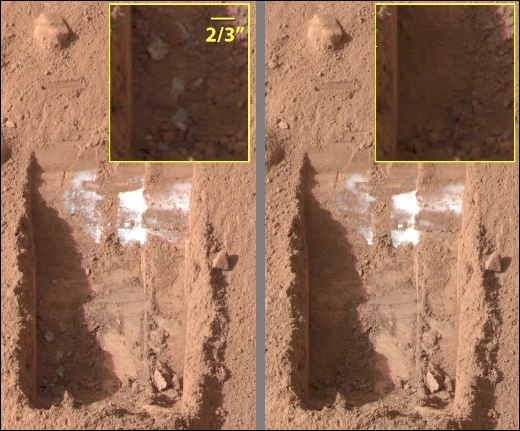화성에서 물 만졌다…NASA 첫 공식확인
[경향신문] 2008년 08월 01일(금) 오후 05:53
탐사로봇이 직접 접촉…생명체 연구 탄력
화성에 물이 존재한다는 사실이 처음으로 확인됐다. 그동안 간접적인 증거들은 여러 차례 나왔으나 직접 입증된 것은 이번이 처음이다. 물의 존재가 확인되면서 화성의 생명체 존재 여부에 대한 연구가 더욱 탄력을 받을 전망이다.
AP통신 등 외신들은 지난달 31일 미 항공우주국(NASA) 발표를 인용, 화성 탐사로봇 피닉스에서 이루어진 화성 토양 실험 결과 물 성분을 확인했다고 보도했다.
피닉스 연구팀의 윌리엄 보인턴 교수(애리조나대)는 기자회견에서 “화성에 물과 얼음이 존재한다는 것은 지난달 피닉스 로봇의 관찰 결과 확인할 수 있었지만, 로봇에 내장된 실험실을 통해 물을 직접 접촉한 것은 이번이 처음”이라고 말했다.
탐사로봇 겸 우주선인 피닉스는 지난 5월25일 화성 북극권에 착륙을 성공해 90일 계획으로 토양 채취 등 탐사활동을 벌여왔다. NASA는 “물 발견에 성공함에 따라 피닉스의 탐사 활동을 5주 연장해 9월말까지 계속하기로 결정했다”고 발표했다.
이전까지는 탐사로봇의 팔이 로봇 속에 내장된 실험실까지 토양 샘플을 옮기는 데 번번이 실패해 화성 토양을 직접 분석할 수 없었다. 하지만 피닉스는 달랐다.
화성 토양을 2인치(약 5㎝) 깊이로 파서 실험실로 무사히 운반했다.
이번 실험 직전 애리조나대 연구진은 피닉스 실험실에 얼음이 포함된 흙을 넣으려다 두 차례 실패했다. 보인턴 교수는 “지난번 실패로 이번 실험에는 마른 토양을 사용했다. 그런데도 가열 장치에 넣고 열을 가했더니 물 입자가 방출됐다”고 놀라움을 표시했다.
유기물 존재 여부는 아직 밝혀지지 않았으며 자료 분석에는 3~4주가 소요된다.
NASA에 따르면 피닉스는 탐사 활동 기간이 연장된 만큼 착륙 지점 인근의 도랑 2곳에서 추가로 샘플 채취 작업에 나설 계획이다. NASA 과학자들은 “피닉스는 현재 양호한 상태이고 태양 전지판의 상태도 괜찮다”면서 “화성에서 가장 흥미로운 지역에서 지금 보유하고 있는 자원을 최대한 활용할 계획”이라고 말했다.
정환보기자 경향신문 & 경향닷컴
***********************************
A panoramic view of Mars taken by NASA's Phoenix lander. Scientists say the probe is sitting on an ice sheet. Photo: Reuters
NASA's Phoenix Mars Lander identifies water in a soil sample from Mars.
**********************************************
Nasa's Phoenix Lander 'Tastes and Touches' Water on Mars
Independent, The; London (UK)
2008-08-01 By Ben Clover
NASA HAS confirmed that the Phoenix Mars Lander has identified one of the crucial ingredients for life in a soil sample.
"We have water," said William Boynton of the University of Arizona, one of the lead scientists monitoring the mission, . "We've now finally touched it and tasted it. From my standpoint, it tastes very fine."
Scientists popped open champagne when they received confirmation that the soil contained ice. Until now, evidence of ice in Mars's north pole region has been largely circumstantial.
The Phoenix Lander's robotic arm found the sample on Wednesday and confirmed its composition through tests of the vapours created when it was heated in an oven.
Dr Boynton said he had described the news as the mission's "Wicked Witch" moment, from the film The Wizard of Oz in which the Wicked Witch exclaims "I'm melting, melting."
The news arrived late last night from the Red Planet, which, depending on it and the Earth's orbits, can be between 33 million and 249 million miles away.
Because of this discovery, the space agency has extended Phoenix's mission and it will receive extra funding to investigate the planet's surface until the end of September, five weeks more than originally planned. Peter Smith, Phoenix's principal investigator, said: "Mars is giving us some surprises. one is how the soil is behaving. The ice-rich layers stick to the scoop when poised in the sun ... That has presented challenges."
The successful scoop came from a two-inch trench and followed two failed attempts. Researchers were able to prove the soil had ice in it after it melted in the oven at 0C (32 degrees Fahrenheit) and released water molecules. The next move is to bake the soil to sniff for carbon-based compounds, which could suggest the presence of basic elements of biology.
Since landing on 25 May, Phoenix has been studying the soil with instruments that include a microscope, chemistry lab, camera and a conductivity probe. It is conducting experiments to learn whether the ice ever melted in the Red Planet's history, and whether that could have led to a more hospitable environment.
Although led by the University of Arizona and managed from Nasa's Jet Propulsion Laboratory in Pasadena, California, the mission has seen contributions from across the world, including Canada, Switzerland, Denmark, Germany and Finland.
The latest scientific finding is the first piece of good news for a mission that has been dogged by difficulties in recent weeks. Scientists had waited with bated breath to learn if their probe's braking system was working and the vessel had landed safely. However, an electrical short circuit on one of Phoenix's eight test ovens threatened to destroy the instrument but scientists said the problem had not recurred.
The Lander, which has spent several weeks drilling into the ice, also had trouble getting the ice shavings into the oven. The Lander has taken 400 pictures to form a colour panorama of the planet's surface and beamed them back to the project's HQ. Mark Lemmon of Texas A&M University said the process of stitching them together was "painstaking" but showed a Martian surface studded with rocks and under a shroud of dust. "Essentially it's an ice-dominated terrain," he said.
Photos taken by the Mars Global surveyor in 2001 and 2005 showed gullies in the side of a crater, seemingly caused by water bursting out the crater wall. In 2002, the orbiting Odyssey spacecraft spied what looked like a reservoir of buried ice. After Phoenix arrived, it found what looked like ice in a hard patch underneath its landing site and changes in a trench indicated some ice had turned to gas when exposed to the sun.
In 2006, Nasa viewed evidence of water moving across the planet's surface.
The extension to the mission in the wake of this success will add $2m (1m) to the current $420m cost.
Phoenix is not the only human presence on Mars at the moment. But unlike the two rovers working near the Martian equator, Phoenix's lifetime cannot be extended much further because it is unlikely to have enough power left to survive the planet's winter.
(c) 2008 Independent, The; London (UK). Provided by ProQuest Information and Learning. All rights Reserved.
A service of YellowBrix, Inc.
'무기리스트 > 세계우주무기' 카테고리의 다른 글
| 무인자동차형 로봇... 중화기 장착 보안 로봇 개발 (0) | 2008.08.06 |
|---|---|
| 세계 100대 방산업체에 한국은 1개뿐 (0) | 2008.08.05 |
| NASA, 토성 위성 '타이탄'에서 액체 존재 확인 (0) | 2008.07.31 |
| 달 과학기지 건설’ 한국도 참여…NASA 다국적 프로젝트 (0) | 2008.07.30 |
| 이란, 우라늄 농축 원심분리기 6,000대 (0) | 2008.07.28 |


